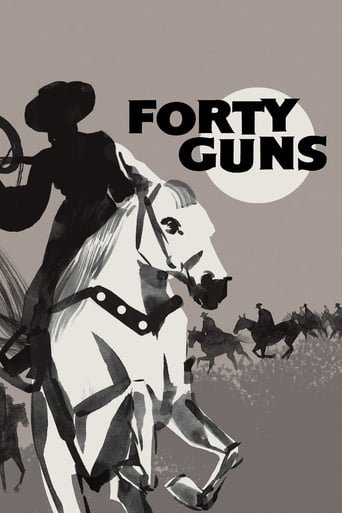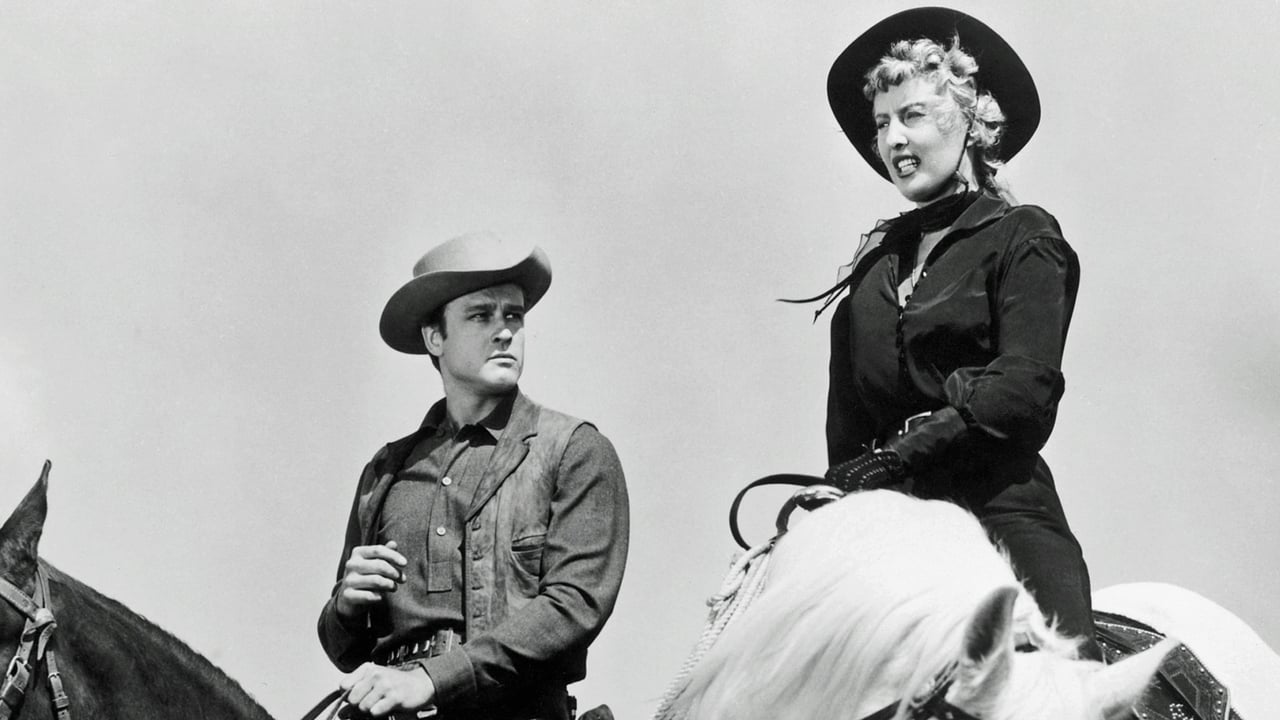Wuchak
Released in 1957, "Forty Guns" is a B&W Western that revolves around an authoritarian rancher, Jessica Drummond (Barbara Stanwyck), who rules an Arizona county with her private entourage of hired guns. When two marshal brothers arrive to set things aright (Barry Sullivan and Gene Barry), the cattle queen finds herself falling for the former. Both have young brothers who are problematic. Eve Brent plays a curvy gun-maker.The movie has a number of positives: The opening sequence is great with its apocalypse of thundering horses led by Jessica on a lone white horse (symbolically?).The tornado sequence is well-done with Jessica getting dragged by her horse and her subsequent monologue after the storm, hooking up with Griff (Sullivan).Eastwood's renowned "Unforgiven" (1992) was obviously influenced by "Forty Guns": Both feature a remote town without justice or law and order, an existential wasteland. Crooked, murderous Sheriff Logan (Dean Jagger), embodying the breakdown of social order, is similar to Hackman in "Unforgiven"; and his suicide is very eerily done. A blind marshal (Worden) is a literal joke on "blind justice" and another symbol of the impotence of law & order.The long shoot-up of the town by the "wet-nose" Brock is grand mayhem. In "Unforgiven" the attack on the prostitute by two young cowboys (also referred to as "boys") serves as the same type of initial, youthful, anarchic transgression which has to be set straight.A gruesome, dressed-up corpse in a coffin, put on full display on the main street, with accompanying, hand-written vindictive placards, is also seen in "Unforgiven." In each it's a grotesque slap to decency and civilization.The town ambush of Griff by Charlie Savage (fitting name) next to a row of empty coffins is effective, particularly the straight-up vertical shot of the window with the assassin's rifle sticking out.While the "Woman with a Whip" song is dated, ill-fitting and corny, the score is otherwise suited to the content.The stylish, irreverent way the movie strays from Western tradition reveals it to be the precursor to the (mostly lame) spaghetti Westerns of the 60s.Other highlights include: The shot of Wes's widow in black against the sky; the leitmotifs of the foal and hearse, representing the extremes of birth and death; the comedy at the baths; the sexy female gunsmith seen through a rifle barrel, a jarring juxtaposition of the feminine and force, as is the case with Jessica.Because of these positives "Forty Guns" is often touted as a groundbreaking Western. While true, it's also a decidedly average 50's Western filled with unbelievable dialogue/characterizations and deliberately contrived scenes, not to mention the story's just dull and it's shot in B&W. Just because it strays from the mold of traditional Westerns doesn't make it a good movie.The film runs 79 minutes and was shot in Arizona.GRADE: C
James Hitchcock
"Forty Guns" effectively recycles what, even in 1957, was already a well-worn Western plot, the one about the tough but honest lawman who arrives in a small western town dominated by a powerful landowner and succeeds in restoring law and order to the community. Many such films were either straightforward retellings of the story of Wyatt Earp or fictionalised versions of the Earp legend ("Dodge City"), and this film falls into the latter category. The central character, Griff Bonnell, is clearly based on Wyatt Earp, and travels everywhere with his two brothers Wes and Chico, just as Earp was assisted by his brothers Morgan and Virgil. The one thing that sets this film apart from many treatments of a similar theme is the sex of the powerful rancher. In this film she is a woman, Jessica Drummond, and it is perhaps inevitable that she and Griff will end up by falling in love. At first, however, Jessica does not seem like a typical romantic heroine. She is a tough, ruthless lady who dominates the town and the surrounding area, ruling her territory with an iron fist and with the help of a gang of hired gunmen, the "forty guns" of the title. Griff originally arrives in the area, in fact, on a mission to arrest one of her men for mail robbery, and he soon clashes not only with Jessica but also with her spoilt, arrogant and sadistic brother Brockie. (The characterisation of Brockie Drummond is similar to that of Dave Waggoman in "The Man from Laramie", another Western of this period). The film was written and directed by Samuel Fuller. He was a director who worked in a number of genres, but I know him best for that excellent film noir, "Pickup on South Street". In some ways the plot of "Forty Guns", if updated to an American city in the mid twentieth century, with Griff as the tough-but-decent cop played by Glenn Ford, and Jessica as the glamorous but shady businesswoman played by someone like Gloria Grahame or Lizabeth Scott, could easily be that of a noir itself. The film has a complex noir-style plot and was shot in an expressionist black-and-white, even though it was made at a time when colour was increasingly becoming the norm for Westerns. (It was, however, far from being the only black-and-white Western from the late fifties; Arthur Penn's "Left Handed Gun" from the following year is another example). It also Barry Sullivan as Griff makes a rather stolid hero, but there is a good performance from Barbara Stanwyck, still strikingly glamorous and seductive in her late forties, as Jessica. (Stanwyck was five years older than Sullivan, but looks considerably younger). There is one striking scene where Jessica is dragged along the ground by a horse. I wondered how this was filmed as it seemed too dangerous for any stuntwoman to have performed, and thought that Fuller had perhaps used a dummy. The answer, in fact, is that Stanwyck performed the scene herself after her stunt double chickened out!The film was shot in CinemaScope, and Fuller uses the widescreen format to great effect. As John Ford has done earlier in films like "Rio Grande", he uses black-and-white photography as an effective medium for showing off the beauty of the Western landscapes, and as in his other films makes extensive use of close-ups. "Forty Guns" is not one of the great Westerns in the way that "Pickup on South Street" is one of the great noirs; the plot is too over-familiar and the acting is not always of the highest calibre. It is, however, a film which still retains some points of interest even today. 6/10
MrSwanny
I came across this gem by chance after half a lifetime of devotion to the spaghetti westerns of Leone and an unshakeable belief that Once Upon a Time in the West is the greatest Western of all. Suddenly the genre makes a lot more sense. From the fantastic opening shots as Stanwyk and her 40 thieves bear down on Sullivan and his brothers, to the numerous murderous shots which come out of nowhere, to the nihilistic pronouncements of all the major characters the overwhelming impression is that all the great modern westerns were paying homage to Forty Guns in a hefty way. Even the musical moments are strangely effective. The funeral song is a haunting hint of the musical "theme" which accompanies Claudia Cardinale's walk through the station in Once Upon a Time. Add to that the smoking sexuality of a mature Stanwyk and some of the best double entendres going and this is 76 minutes of economic, cult Western heaven. Don't miss it , Clint's tension building walks down "Main street" took their first steps here !
funkyfry
Sam Fuller actually made a good number of westerns in his early career, and thanks to DVD we are finally able to see these at home just in these past few years. I can't say how long I was looking for "Baron of Arizona." Pleased to say that this one is just as ambitious and fulfilling as the other two that I've seen, "Baron" and "I Shot Jesse James." Barbara Stanwyck is welcome in ANY western film as far as I'm concerned, and Barry Sullivan's "long walk" is the most stylish you'll ever see. Dean Jagger provides his usual characterization of a conflicted and compromised noble man.Fuller centers the film around a few key scenes, specific confrontations that define the rest of the action surrounding them. His sense of style in terms of the characters and their interactions with their surroundings is impressive. For instance the scene with the man who's supposed to trick Griff into an ambush -- we really get to know that character and sense his fear just in a short time. I love how he and his actors make use of accidents and physical limitations of the sets. For instance there's a bit where Sullivan is running towards the action and a tumbleweed comes across his path, and he leaps across it in a really stylish way. In some circumstances that could have become a ruined take, but Fuller obviously has his actor so much into the spirit of the scene that he basically reacts in character. You can sense Fuller's ability to focus his actors that way hanging over both the action and dialog scenes.I'd have to see the film again to really say much about its theme or its subject, but it seems to be in the classic mold of westerns about the end of the "Old West." Stanwyck and Sullivan represent different types of iconic western presence that will depart from the world forever with that ending.The conclusion of the film is a bit underwhelming, but other than that I really have no complaints about this film. It's fine western entertainment from the closing days of the western about the closing days of the west.


 AD
AD





